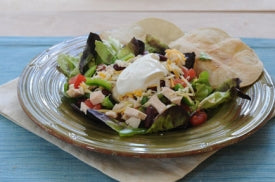Cool Beans
Yes, we all know that beans are the musical fruit. But did you also know that they're magical?
I mean, not magic magical, but beans are an inexpensive, tasty, and nutritious powerhouse! Today I want to introduce you to the joys of beans. And we'll even talk strategies for making them less musical too.
14% of the U.S. population is eating beans on any given day. Pinto beans are the most popular bean, closely followed by navy, black, Great Northern, and garbanzo beans. These versatile legumes even fit into two distinct MyPlate groups -- vegetables and protein. Did you know that beans can be considered a healthful protein food or a fantastic vegetable option? Fit them on your plate wherever they can do the most good.
 So, why eat beans? In a word: nutrients. They're full of them! Beans are great sources of...
So, why eat beans? In a word: nutrients. They're full of them! Beans are great sources of...
 A single serving of kidney beans has 20.5 fewer grams of fat, 6.5 more grams of fiber, and 48% fewer calories than lean ground beef! This means that beans are as great a bet for your health as they are for your wallet.
So, how can you make beans a part of your life?
Well, when it comes to canned beans, it's as easy as draining and rinsing them, then tossing them into your next salad or batch of chili.
Dried beans require a little bit more effort. There are a few tried-and-true approaches, which I've outlined below...
A single serving of kidney beans has 20.5 fewer grams of fat, 6.5 more grams of fiber, and 48% fewer calories than lean ground beef! This means that beans are as great a bet for your health as they are for your wallet.
So, how can you make beans a part of your life?
Well, when it comes to canned beans, it's as easy as draining and rinsing them, then tossing them into your next salad or batch of chili.
Dried beans require a little bit more effort. There are a few tried-and-true approaches, which I've outlined below...
 Phew! That was a lot of information about beans. It's time to get practical. Here are some great (and free!) recipes for canned and cooked beans alike.
Phew! That was a lot of information about beans. It's time to get practical. Here are some great (and free!) recipes for canned and cooked beans alike.
 For More Information:
For More Information:
 Mediterranean Meals Poster
Mediterranean Meals Poster
 So, why eat beans? In a word: nutrients. They're full of them! Beans are great sources of...
So, why eat beans? In a word: nutrients. They're full of them! Beans are great sources of...
- Folate
- Iron
- Magnesium
- Plant protein
- Polyphenols
- Potassium
- Resistant starch
- Soluble fiber
- Total fiber
- Zinc
- Reduce your LDL cholesterol levels.
- Reduce your risk of heart disease.
- Decrease your risk of diabetes.
- Help you manage your weight.
- Improve the health of your colon.
- Be rich in vital nutrients.
 A single serving of kidney beans has 20.5 fewer grams of fat, 6.5 more grams of fiber, and 48% fewer calories than lean ground beef! This means that beans are as great a bet for your health as they are for your wallet.
So, how can you make beans a part of your life?
Well, when it comes to canned beans, it's as easy as draining and rinsing them, then tossing them into your next salad or batch of chili.
Dried beans require a little bit more effort. There are a few tried-and-true approaches, which I've outlined below...
A single serving of kidney beans has 20.5 fewer grams of fat, 6.5 more grams of fiber, and 48% fewer calories than lean ground beef! This means that beans are as great a bet for your health as they are for your wallet.
So, how can you make beans a part of your life?
Well, when it comes to canned beans, it's as easy as draining and rinsing them, then tossing them into your next salad or batch of chili.
Dried beans require a little bit more effort. There are a few tried-and-true approaches, which I've outlined below...
- Overnight: Cover your beans with several inches of water and let them soak in a large pot overnight. Then, when you want to cook them, drain and rinse the beans, cover with a few inches of fresh water and bring the whole shebang to a boil. Let everything boil for a few minutes, then reduce to a simmer and cook for a few hours, until beans are tender.
- Quick: For a quicker method that skips the overnight soak, bring beans to a boil in a large pot. Boil for 2-3 minutes, then turn off the heat and let them soak for an hour. Bring everything to a boil once more and then simmer for a few hours, until beans are tender.
- Age of the beans
- Altitude
- Bean variety
- Water hardness
 Phew! That was a lot of information about beans. It's time to get practical. Here are some great (and free!) recipes for canned and cooked beans alike.
Phew! That was a lot of information about beans. It's time to get practical. Here are some great (and free!) recipes for canned and cooked beans alike.
- 10-Minute Bean Soup
- Baked Beans
- Barbecue Bean Dip
- Caribbean Bean Salad
- Mediterranean Bean Soup
- Three Sisters Soup
- Tostada Salad
- Vegetarian Chili Pot
 For More Information:
For More Information:
- Dry Beans. http://www.ers.usda.gov/topics/crops/vegetables-pulses/dry-beans.aspx#.VDxOWudN3U4
- Nutritional and Health Benefits of Dried Beans. http://www.ncbi.nlm.nih.gov/pubmed/24871476
- Beans and Peas are Unique Foods. http://www.choosemyplate.gov/food-groups/vegetables-beans-peas.html
- The World's Healthiest Foods: Black Beans. http://www.whfoods.com/genpage.php?tname=foodspice&dbid=2
- Cost of groceries. Peapod.com
 Mediterranean Meals Poster
Mediterranean Meals Poster














